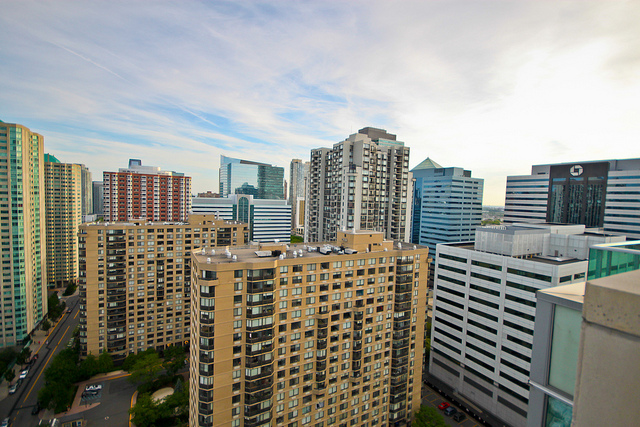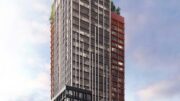The pace of new residential construction is picking up in New York City, but it’s the west side of the Hudson that is undergoing the region’s most dramatic building boom.
On a per-capita basis, Hudson County and Bergen County in New Jersey have issued far more building permits than the five boroughs over the past several years, thanks to strong market demand, significantly lower construction costs, and a willingness of some New Jersey municipalities to seek out and plan for dense, transit-oriented development.
Consider that since January of 2012, nearly 15,000 new building permits were issued in Brooklyn. But if the borough had issued the same number of permits as Hudson County, on a per capita basis, there would have been almost 37,000 permits issued in Brooklyn over that time.
“Many communities in New Jersey that do have access to transit have been very pro-active about zoning for mixed use, higher density, transit-village appropriate development,” said Courtenay Mercer of the Regional Plan Association. “A lot of them recognize this as a great way to promote economic development.”
Brian Stolar of the Pinnacle Companies, a developer active in northern New Jersey, says that many cities want to take advantage of market trends favoring urban living.
“Some of the municipalities are recognizing that one, it’s a trend you don’t want to get in the way of, and secondly it is good for their own proceeds as a source of revenue.”
While a lot of new development is planned for Jersey City and the “Gold Coast,” there is also a lot of recent activity in cities and towns further inland, like Secaucus, Lyndhurst, the City of Orange, Harrison and Newark. Developers are reacting to strong market demand and are also attracted by lower construction costs than what they would pay in the five boroughs.
“This is a widespread phenomenon outside of the Gold Coast,” said Tim Evans of New Jersey Future, a non-profit group that advocates for transit-oriented development in the state. “It’s a real thing. It’s not just the cities – it’s the older towns.”
Many new residential developments in New Jersey are a result of the state’s redevelopment process, in which municipalities declare certain areas in need of redevelopment, develop a new zoning regime for the area, and in some cases acquire or condemn property for redevelopment. The municipality then offers developers tax abatements in the form of “payments in lieu of taxes,” or PILOTs, though these abatements are generally not as generous as those given in New York City through the 421-a program.
There are 40 redevelopment areas in Jersey City alone, according to the Jersey City Redevelopment Agency’s website. In Harrison, a town just east of Newark with a stop on the PATH train, dramatic redevelopment of the station area occurred as part of a redevelopment initiative.
“Those projects are all being done under the formal redevelopment process,” said Joseph Maraziti, a land use lawyer that has represented municipalities in matters of land use and redevelopment. “It is very process-oriented, strict and time consuming, but powerful, in terms of the outcome.”
In Harrison, the results have been powerful indeed, as the entire station area has become transformed by new mixed-use developments appealing to Manhattan commuters.
“In New Jersey there are virtually no as-of-right [multi-family] projects,” said Ronald Ladell, Senior Vice President of AvalonBay Communities, referring to projects that abide by the existing zoning code and don’t need any discretionary approvals. AvalonBay has recently completed projects in redevelopment areas in North Bergen, Wood-Ridge and Bloomfield.
“In Hoboken, a lot of those projects are redevelopment projects, they’re not as-of-right development,” said Maraziti, noting that the redevelopment process is often beneficial for both the municipality and the developer. “In the redevelopment process the city can be true partners and shape the outcome of the project – the timing, design, all the details – and also extract parks, amenities, infrastructure improvements.”
At the same time, the tax abatements and structured payment schedule make it easier for developers in the early years of a project to line up financing and to “make the numbers work.”
“One of the factors that assists a city’s rejuvenation is when there is strong political leadership, whether from the mayor or other governing body, along with talented municipal professionals,” said Ladell of AvalonBay. Jersey City in particular is known for its strong leadership and high-quality planning staff.
Some municipalities require developers to include affordable units or to contribute to affordable housing funds. Montclair in Essex County, for example, requires that 10 percent of the units in new developments to be affordable in its redevelopment areas.
But even the market-rate housing in many New Jersey communities is affordable by New York standards. New condos in Jersey City and Hoboken can be found for between $500 and $700 a square foot. Comparable condos in Long Island City and downtown Brooklyn, on the other hand, are asking between $900 and $1,000 per square foot.
This value is attracting migrants from New York City, though a large number of New Jersey residents are also moving to the five boroughs. About 7,700 New York City residents moved to Hudson County in 2012, according to Census data, while 5,500 people from Hudson County moved to New York. In the case of Bergen County, more people moved to New York City than made the reverse migration.
Talk about this topic on the YIMBY Forums
For any questions, comments, or feedback, email [email protected]
Subscribe to YIMBY’s daily e-mail
Follow YIMBYgram for real-time photo updates
Like YIMBY on Facebook
Follow YIMBY’s Twitter for the latest in YIMBYnews





